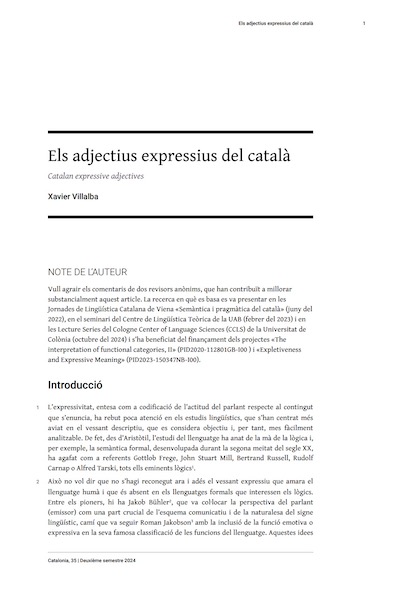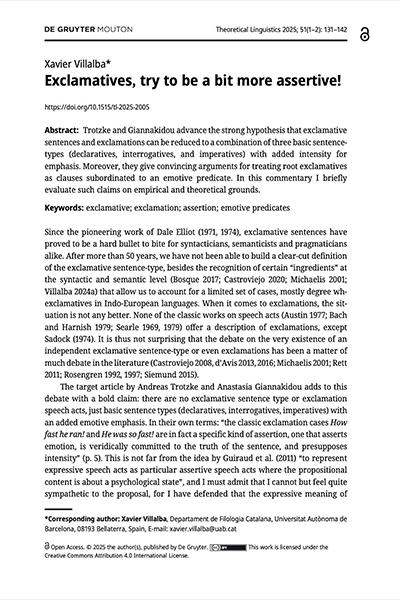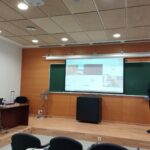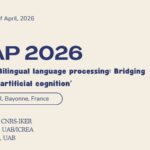6 març, 2022
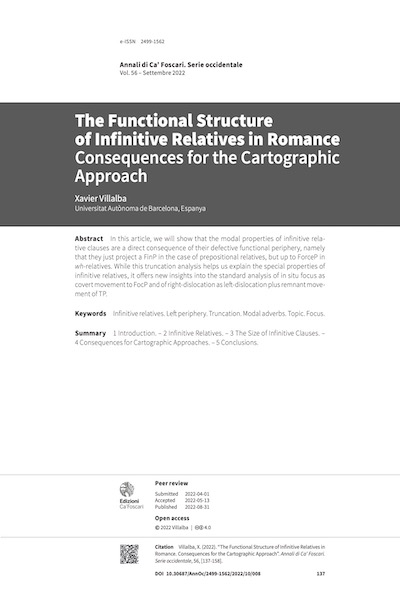
Autors:
Xavier Villalba
Títol:
The Functional Structure of Infinitive Relatives in Romance. Consequences for the Cartographic ApproachEditorial: Annali de Ca' Foscari, Venice University Press
Data de publicació: 31 agost 2022
Més informació
Text completIn this article, we will show that the modal properties of infinitive relative clauses are a direct consequence of their defective functional periphery, namely that they just project a FinP in the case of prepositional relatives, but up to ForceP in wh-relatives. While this truncation analysis helps us explain the special properties of infinitive relatives, it offers new insights into the standard analysis of in situ focus as covert movement to FocP and of right-dislocation as left-dislocation plus remnant movement of TP.
5 febrer, 2025

Autors:
Real, Espinal & Villalba
Títol:
Vaya in Spanish. From a judgment to a commitment markerEditorial: Journal of Historical Syntax
Data de publicació: 05-02-2025
Pàgines: 26 Més informació
Text completIn this paper we show the diachronic development of Spanish vaya, which goes from a form of the motion verb ir ‘to go’ to an epistemic verbal discourse marker (VDM) associated with the speaker's judgment regarding a proposition (e.g. ¡Vaya! ‘Wow!’ or ¡Vaya que es donoso! ‘How funny you are!’), and then to a VERUM marker (Leonetti & Escandell-Vidal 2009, Gutzmann, Hartmann & Matthewson 2017) encoding the speaker's strong commitment to the truth of a proposition (e.g ¡Vaya si se casa! ‘You bet he's getting married!’). We argue that this shift is a clear case of a run-of-the-mill process of grammaticalization involving three stages and each change corresponds to a different position of vaya in the articulated Speech Act layer advocated by Manfred Krifka (2021). When vaya expresses a subjective epistemic attitude of the speaker, it is postulated in J(udgement)P(hrase), a position associated with epistemicity and evidentiality; when vaya expresses a strong commitment of the speaker to the truth of the proposition it precedes (i.e., a VERUM marker), it is postulated in the higher Com(mitment)P(hrase). All in all, this study argues that the grammaticalization path of vaya is not only unidirectional (against previous analysis like Octavio de Toledo y Huerta 2001 and Company Company 2008), but rather obligatorily implies a bottom-up reanalysis (Roberts & Roussou 2003).
26 setembre, 2025
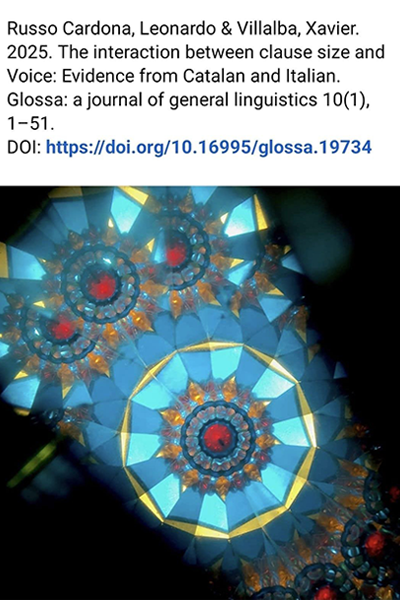
Autors:
Russo Cardona, L. & Villalba, X.
Títol:
The interaction between clause size and Voice: Evidence from Catalan and ItalianEditorial: Glossa: a journal of general linguistics 10(1)
Data de publicació: 18 de setembre de 2025
Més informació
Text completWe argue that in certain reduced embedded clauses Voice behaves differently from most other contexts, on the basis of tough-constructions (TCs) and modal passives (MPs) in Catalan and Italian. These constructions involve an A-dependency targeting only internal arguments of morphologically active transitive infinitives (unlike control, raising, and restructuring dependencies) because they involve a C/I-less VoiceP complement with a defective Voice layer (no accusative, no passive morphology, passive-like implicit agent). Thanks to the existence of a resumptive variant of TCs/MPs in Catalan, we propose a way to derive the distribution of defective Voice, which must be directly selected by a suitable lexical category, with regard to active/passive Voice, which must be directly selected by a functional head (at least in the languages at issue). Our findings bear on the broader theoretical debates about the typologies of Voice, clausal complements, and on the syntactic correlates of clause size.



